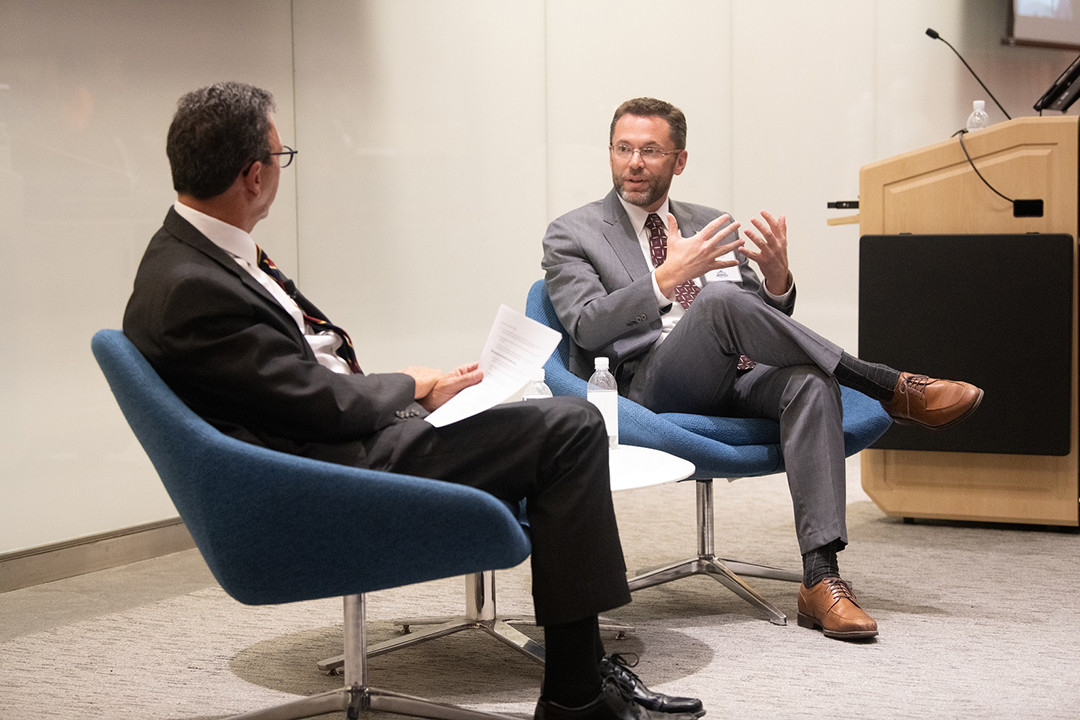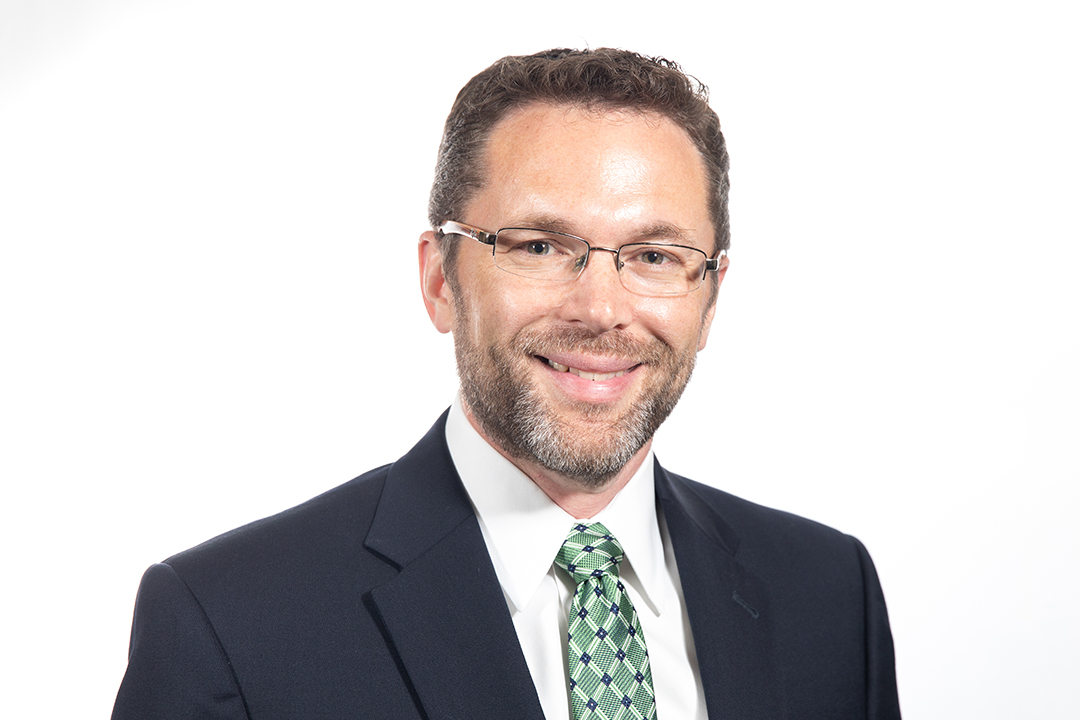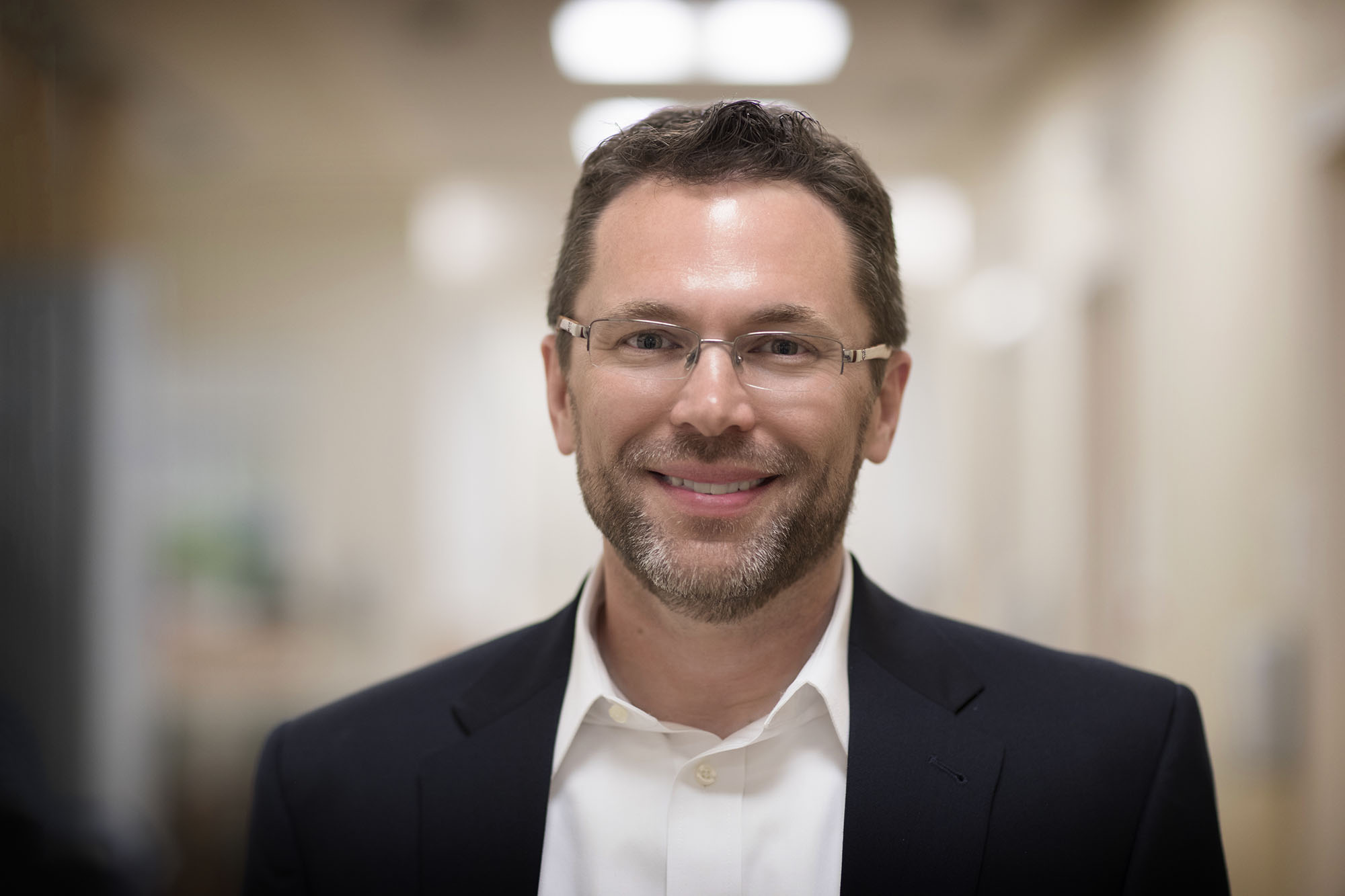By Kristen Mitchell
Since joining the George Washington University School of Engineering and Applied Science in August, Dean John Lach has been having conversations with students and brainstorming with faculty to develop a shared vision for the school’s future.
Dr. Lach believes the school’s future lies in the intersection of cutting-edge research interests, where innovative and interdisciplinary teams can focus on societal impact. He sees GW as an academic institution that will provide future STEM leaders with the technical education they need to succeed, while also giving them the comprehensive tools they need to be leaders in their respective fields.
GW Today sat down with Dr. Lach to discuss his plans for the future of SEAS.
Q: How do you see the role of School of Engineering and Applied Science dean?
A: I always tell the faculty and staff that my job is to help them do their job, and for the students, my job is to help make sure their experience as a student is everything it should be at a great institution like GW. I spend a lot of time talking to our students and asking them why they chose to come here. The first-years and sophomores tell me about what their aspirations are, what experiences and opportunities they hope to have during the time they’re here. I ask our juniors and seniors to tell me about their experiences: what are the things that they love that we should make sure we continue to do well, what are the things we need to work on?
From a leadership perspective, it’s helping cultivate the strategy—and that’s not just internal to SEAS, that’s working with the other deans and the provost and everybody across the campus about the role of SEAS here at GW. So much of what I hear from our students and faculty are the opportunities that they see to connect to other strengths around the university and around the D.C. area. Getting that input will make us able to set the school on a strategy that is going to best position our stakeholders and our university to pursue its mission.
Q: Why is now an exciting time for SEAS?
A: The school is in extremely good shape. I give my predecessor David Dolling and his team a lot of credit for really creating a strong foundation for this school. When I was interviewing I was basically looking for all the problems, looking for the red flags, the dirty laundry, and I just couldn’t find any of it. Then I got here and I realized, ‘No, this is a really, really well run school.’ We have a great community of faculty, staff, students, and alumni, we have a world-class facility, and we are in good financial shape.
The question now becomes, what’s next? What are the opportunities ahead of us? Those are the questions that any new dean wants to focus on. That’s what’s been so exciting for me, and I think it’s exciting for everybody in the school. We all hope that SEAS can play an increasingly large role in our university, partnering with the other schools to collectively achieve our goals.

Dean Lach (right) speaks with Frank Sesno during a Colonial’s Weekend event.
Q: How is SEAS supporting collaboration across departments and schools to develop and grow high-impact research?
A: In conversations I have with all the various SEAS stakeholders, what I keep hearing and, what I believe myself, is that the greatest opportunities for the school going forward are at the intersections of traditional disciplines. Part of that is the recognition that we are a relatively small engineering school. Other schools are much larger, they have more resources, some of them already have more established reputations as engineering schools than we do, so it would be difficult to compete toe-to-toe. Our impact is going to be about differentiation, finding areas where there is a lot of potential for societal impact, for example, but based on connecting together multiple existing strengths that we have.
Last month we organized our first ever school-wide research retreat. We went out to the Mount Vernon campus for the day, and the faculty were charged with putting ideas forward with faculty from various departments and schools. It was all about brainstorming areas of opportunity for the school and what kinds of investments would enable us to have an impact. There was a great comment a faculty member made; he observed that we often talk about the size of our school as being a limitation, but the fact is we can all fit in a room together and have a discussion about these research ideas. Not many engineering schools can do that. That smaller size gives us the agility to pivot and pursue areas of opportunity that larger schools can’t.
Based on these conversations, I’ve put forth a strategy to rethink the way we do faculty hiring, which is traditionally very departmental. Over the next few years our faculty allocations will be made to these interdisciplinary research initiatives rather than to the departments, so it will be the faculty who are driving these initiatives and the faculty searches. The people we hire will have departmental appointments, of course, but the strategy around faculty hiring will be driven more by those areas of opportunity that aren’t limited by departmental boundaries.
Q: How is SEAS enhancing the student experience through both educational and extracurricular experiences?
A: When I talk to students about why they chose to come here, the first letters out of their mouths are usually ‘D.C.’ When it comes to curriculum, students say they chose to come here because they want to study engineering, but they want to do that within the broader D.C. context.
I had a conversation with one of our senior undergraduates who framed this concept really well. She wants to be a transportation engineer and is in our civil engineering program. She realized if she was truly going to become a leader in transportation engineering, that in addition to the technical things she was learning in civil engineering, she also needed to understand public policy, urban planning and social justice. Because she is at GW, this wonderful comprehensive university, she was able to go and find courses in those areas and then petition to have them count toward her degree. She’s interviewing for jobs now, and employers are recognizing how valuable that is.
Part of what I took away from that is we could be the engineering school that gives you a really strong technical education, but also gives you exposure to other things that will position you to be a true leader once you get out into the world, things like public policy, law, health, international affairs and business. This would differentiate us from other schools. I’m hearing from the students that this is what they want; that’s the intuition that is bringing them here – to become leaders in their fields in order to have a societal impact. We need to make good on that intuition.
So we’re having some really important conversations right now. It’s starting with this self assessment of what are we really proud of, and what would we like to be able to say about ourselves in three to five years. That will drive the kind of investments we make.
Q: What efforts has SEAS made toward making a high-quality STEM education more accessible through online programs?
A: Online education is a competitive space. There are so many options out there, and geography and enrollment capacity are no longer barriers. So the question becomes, what’s the motivation for someone to take a program from GW as opposed to another university? SEAS has done very well answering that question by providing both distinctive programs and high quality of service. One of the great examples of that is the master’s in cybersecurity policy and compliance, which is a very popular online program that serves a large number of students but provides a personal touch.
In the recent U.S. News and World Report rankings, GW ranked 15th in the country for Best Online Master's in Engineering Programs. That’s up from in the 50s just a couple years ago. That is a reflection on the excellent work our faculty and staff have done on these programs.
Q: What is SEAS leadership doing to continue building on the school’s gender diversity?
A: Forty percent of our undergraduate students are women, which is almost twice the national average and is 10th in the country for undergraduate engineering schools. There is a lot the school has done to create an environment that promotes gender diversity, and we’re really thinking about how we can build on that strength of gender diversity at the undergraduate level to achieve broader diversity and inclusion in all of its forms and in all of our stakeholder groups. Those are things where we have to be very intentional, they don’t just happen.
I believe we can also become leaders in diversity and inclusion in the field of engineering in general. We’ve had some conversations with some of our alumni who said industry needs that as well. We can do these things here in academia, but then what happens out there in the world? The culture in high tech is still not great around these kinds of issues, and you see attrition of women and underrepresented minorities in many companies. If we become leaders and innovators in this space we can partner with these companies, government agencies and other universities to help them work on their own culture. That’s the kind of broader impact that could be really transformative for the field of engineering.
Q: What can the students expect from you as dean?
A: They can expect me to honestly want to hear from them about their ideas, what they love about this place, what we need to work on, and how we can help them achieve their goals.
They can also expect me to be very aspirational, I’m a listener, I’m a solicitor of input, and I’m always trying to make things better.



